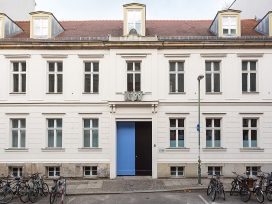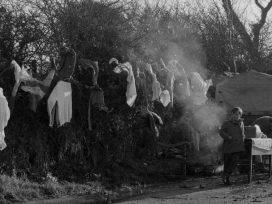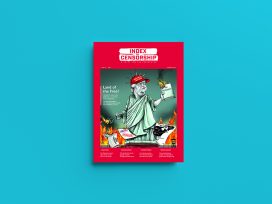As a journalist who did not directly experience the conflicts between the media and the government authorities in Slovenia in the 1980s, that decade, particularly its latter years when the media finally escaped the control of the government and became “the fourth estate”, was not only an interesting, but an heroic, period. 1989, the year the Berlin Wall fell and the Eastern bloc collapsed, was not Slovenia¹s annus mirabilis. Nevertheless, in 1989, the right to free speech and freedom of the press was finally guaranteed in Slovenia after a long series of battles fought by civil society and the media against the socialist system of self-management. These battles were waged with the support of dissidents, especially those from the other Yugoslav republics who had found a media haven in Slovenia. Specifically, the media and civil society fought against Article 133 of the Yugoslav criminal code, which allowed criminal prosecution for “verbal offences” and which the authorities used to persecute their political opponents. The elimination of this article was one of the central demands of the democratic public and media, which at the time, though not too loudly, also supported the then liberal communist leadership of Slovenia.
For this reason, 1989 was, at least as far as Slovenia was concerned, only the climax of a more than ten-year maturation of editors and journalists who, during the preceding decade, bravely opened the media, especially newspapers and magazines, to the possibility of taking an “offensive” perspective on society. Along with other factors, they thus created a suitable climate for the social revolution that would lead to parliamentary democracy. In other words, the basis for honest debate and negotiation about the future of Slovenia – and also Yugoslavia – was established between different spheres of civil society: the Yugoslav Communist Party and the Yugoslav Army (JNA) on the one side, and on the other the leadership of the Slovenian League of Communists and the government of the Republic, which in many cases acted as a buffer zone between Slovenian civil society and the JNA and federal administration. At that time, the written and spoken word in the media was coyly daring and yet it carried considerable weight. Because of their democratic leanings and their courage, journalists and editors enjoyed enormous credibility in society. Although the space for criticism of the party authorities was relatively narrow, and the method of criticism was Aesopian and refined, and what was written in the media had a strong impact. Few of the authorities had sufficient power or were willing to intervene against the media with overt censorship.
Of course, editors still had “conversations” and “consultations” with government officials but this took place in the context of the pluralization of society and political struggles, the outcome of which was not yet clear. There was a press council in the Slovenian republic and various “coordination” committees that exerted formal authority over the media, its “uncontrolled control” as it were. This did not mean, however, that the media were the transmission mechanism of “the communist centre” to be followed without question. Instead, in the second half of the 1980s, ad-hoc groups of politicians and pundits attached themselves to particular media. Although the government subsidized the production of the print media and the level of internal democratization varied in individual organizations, the media became increasingly autonomous as supervisory power gradually eroded. This process did not progress without bitter controversy, and the party continued to have significant power in the editorial boards of individual media organizations which were mostly composed of people other than editors who evaluated the content of the media and also had the power to remove editors. In the early 1980s, this occurred at the legendary satirical newspaper Pavliha and at the political weekly Teleks, which had regularly exposed problems in society.
There has been little professional research in Slovenia investigating and comparing issues of press freedom and media operations in 1989 and 2009 and their relation to the development of democratic processes in the countries of eastern Europe, the former Yugoslav republics and in Slovenia itself. What research there is says too little about how the media space was actually structured 20 years ago and what role was played by the ideology of the social responsibility and utility of the media, which still had a major impact back then. The terms autonomy, freedom and democratization of the media have little meaning on their own, acquiring it only in a concrete historical and social context. Joze Vogrinc, sociologist of culture and media at the Ljubljana University Faculty of Arts, writes:
In no socialist country was the formal unity of the democratic-centralist communist party able to silence real serious disagreement between the political and public sphere. Therefore the media could provisionally, if its editors were suitably assisted by political protectors, express autonomous opinions on those areas of society where criticism was not taboo. Of course, this freedom was fragile, uncertain and dependent on the personal preferences and circumstances of those in power. At the same time, journalists were not stifled by the need to make a profit. On the contrary: it was clear that the media was not a product like any other, but a public good and a means of social self-awareness.
It is interesting that the thesis that the media was not a standard product, but a means of social self-awareness, was deeply felt in the 1990s when Slovenia already enjoyed a form of “domestic” liberal capitalism. Even today, a number of media experts and journalists have warned that the media cannot be abandoned to the crude logic of the market, because they are “something more”, a different sort of “product”. Nevertheless, the list of media that were privatized during the 1990s is long. In 1988, Slovenia, with its population of 2 million, published 785 newspapers of which three were dailies (Delo, Dnevnik and Vecer), two were biweeklies, 29 were weeklies and 226 monthlies. Since all of these publications received government subsidies, their owners and founders had control over content but not finances. Media houses determined the production costs of their publications and these were generally higher than the sales price.
It was particularly true that the major dailies had “national importance” and, for this reason, needed to be protected from the excessive and negative effects of the market. The government recognized the significance of the media as “an activity of special social importance” and during the 1990s subsidized their development primarily through investment in the printing and production process. As a result, all three dailies were able to conduct business in the free market; their printing presses and distribution networks survived the introduction of competition and confirmed their position on the market. Today, these three dailies continue to dominate with a 90 per cent market share. A number of new dailies – Slovenec, Republika, Jutrajnik – tried to break into the market during this period but failed despite political support.
Nevertheless, the media map in Slovenia has changed significantly in these past 20 years. New electronic media have made a strong showing and several foreign houses publish newspapers on the Slovenian market. In addition to national television, there are three new commercial television stations all in the hands of foreign owners. Radio stations, in contrast, tend not to be foreign-owned. The 19 local and regional radio stations that operated before 1990 have been privatized and their most important owners are local authorities. Foreign ownership of the print media includes the Swedish group Bonnier Business Press, which owns the daily Finance, the Austrian Leykam group, which publishes the free daily Dobro jutro, Styria Medie EG, which produces the free weekly Zurnal and, since October 2007, the free daily Zurnal 24. The Belgian publisher Roularta Media Group is the majority owner of the free City Magazine. Slovenia now has eight daily publications that provide general information.
Addressing the specific quality of the Slovenian media space, Sandra Basic Hrvatin and Marko Milosavljevic point out that:
The democratization of the media was limited to the question of how to change (democratize) the ownership of the media. In the print media, freedom of public speech was soon equated with freedom of ownership. The opinion predominated that the privatization of the media (the determination of owners in a media space that until then had no owners) would ensure the non-intervention of the government in the media. Advocates of total deregulation referred to the bad experience under the previous regime as justification for preventing any intervention of the government into media functions in the future.
It soon turned out that a “private” unregulated owner who had purchased a media outlet from the state or from employees could be equally dangerous to press freedoms. In Slovenia, economic deregulation, especially of the print media, caused a number of irregularities. The new corporate owners behaved in an even more ruthless fashion than the state. Though it had been anticipated in the 1990s that it would be possible to preserve diversified ownership in the media and that employees would enjoy a significant ownership stake, the relentless logic of the market and its concentration prevented that. We can therefore conclude, with Vogrinc, that for the time being journalists play the role of “salaried workers in companies that must produce profits”.
Because the state was deprived of ownership in the media, politics had to find another way to exert control. Sandra Hrvatin and Brankica Petkovic argue that the Slovenian media system, rather than being comparable to the western corporatist model, is Mediterranean. Characteristic of the Mediterranean system is that “owners use the media to intervene in politics, while regulation and management of the public television service are under the supervision of the government or of the parliamentary majority”. The two authors supply ample proof that there has been a symbiosis between political (party) power and economic power in Slovenia. A striking example of this kind of behaviour was in 2004 when the centre-left government was replaced by a centre-right government that, in the name of pluralization of the media, made a crude power grab. It did so above all through a politically motivated redirection of advertising by government and para-government entities away from actors critical of the new government to those who were more supportive of it. Such interventions were typical of previous governments as well, though after 2004 the “government-mandated” retreat from certain advertisers was so strong that some media outlets were on the brink of folding.
The many twists and turns of the notion of media pluralism make for a strange story. The idea originated in the law passed in 1994 that required state publications to guarantee the pluralization of the media space. Following media laws passed in 2001, the government – or more precisely, the relevant commission in the Ministry of Culture – assigned 1.7 billion SIT (approx. 7.1 million euros) over the course of three years and an additional 995 million SIT (approx. 4.1 million euros) after the law was amended in 2006. No one has authenticated these sums but a quick look at the recipients would indicate that the government was much more generous to the media outlets that were friendly to it.
The battle to control the media remains hottest around public service television, RTV. Since the change in the social system, there have been six “innovations” at RTV. In 2005, the year after the Centre-Right government took power, a new law on RTV was passed; this was pushed through despite only minimal support expressed in a public referendum. Studies indicate that editors of individual departments, as well as guests and pundits, were selected on the basis of political alignment. Political staffing at RTV and at some of the most important print media as well as the interference of political-commercial lobbies in editorial policies was so severe that, in 2007, 570 journalists signed a petition against censorship and political pressure that limited journalistic autonomy.
If we are just a little cynical, we could say that in the process of its conflict with the journalistic community, the previous centre-left government actually succeeded in exposing the key links between business, media and politics, and offering them up to the critical judgment of the public. Now that these links have been revealed, a new set of laws governing the media is being prepared. We can only hope the lawmakers understand the dependence of journalists and editors on media owners and recognize the pressures to limit freedom of speech and the press, the autonomy of journalists’ work and their duty to tell the truth as they see it.
Slovenia has recently been debating a number of interesting ideas that, in light of the bad experiences of the past and the current economic crisis, seem bold and ambitious. The critical and analytical media are becoming a sort of agora where reflections on how to tackle the crisis and its aftermath are published. It appears that sufficient public capital is being gathered to prevent the ongoing erosion of journalistic autonomy, regardless of what party is in power. However, in order to ensure journalistic autonomy, it will be necessary to establish the permanent separation of the information media from the advertising and public relations arms. Information media must also have an autonomous status vis-à-vis the financial and management departments of news organizations. “Why, 20 years after, do we not take the autonomy of the media seriously?” wonders Vogrinc. This means that the media must be treated “not only as a profitable enterprise, but also as a public good”. Although Slovenia was close to achieving this situation in 1989, a return to it today, though extremely complicated and fraught with difficulty, remains one of our most urgent tasks.






